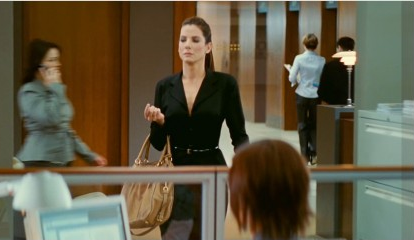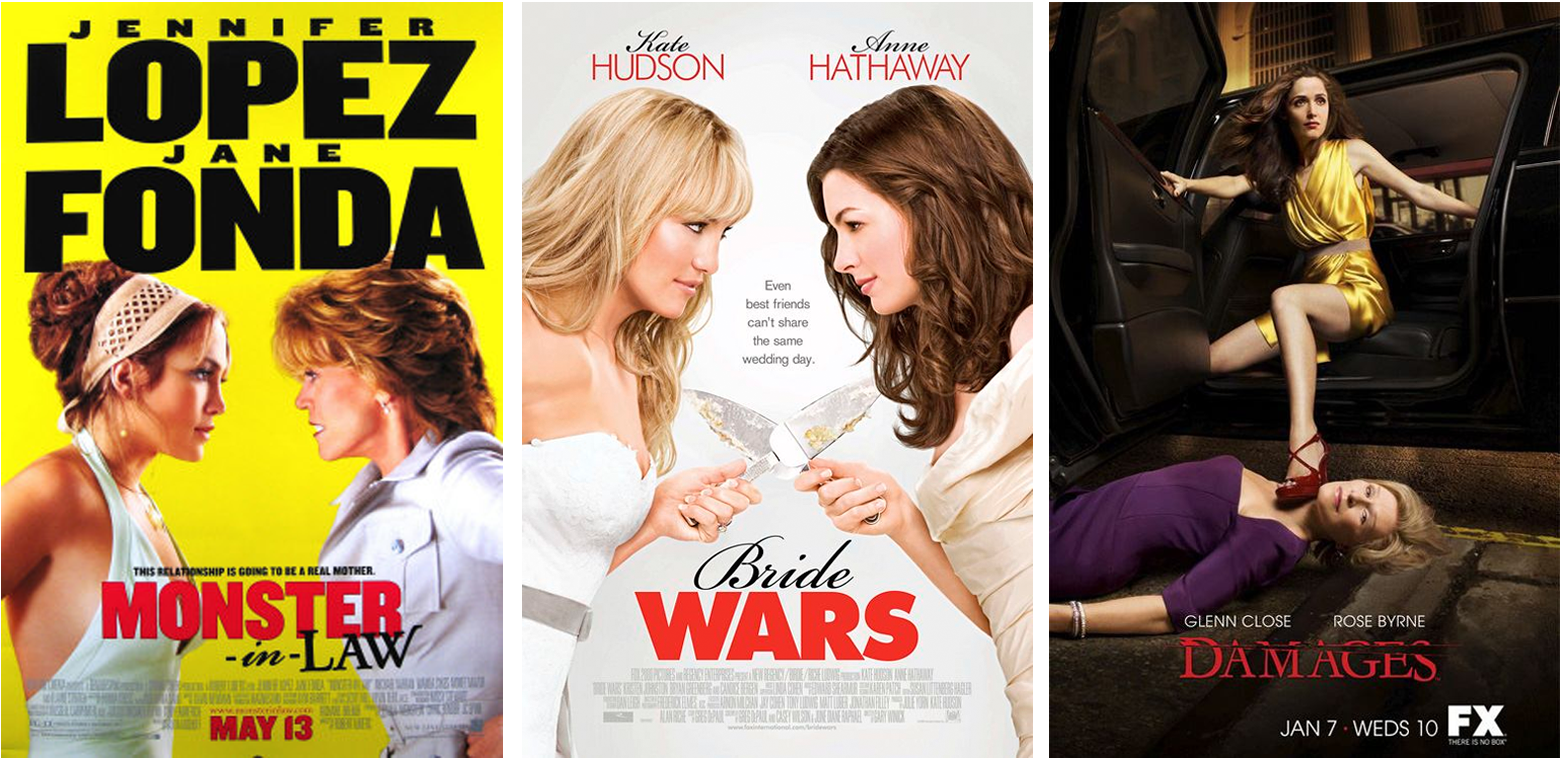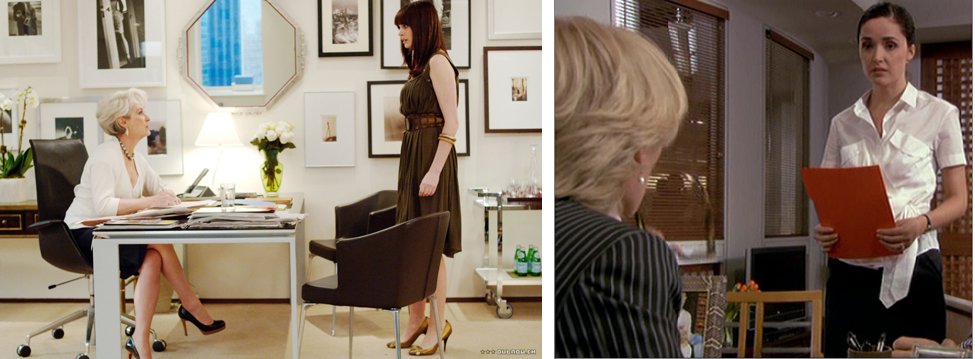“Attack of Boss-zilla!” – Female Conflict and Generational Discord…
Hannah Hamad / Massey University
“Attack of Boss-zilla!” – Female Conflict and Generational Discord in Postfeminism’s New Monstrous Feminine
Hannah Hamad / Massey University

In 2009, journalist Ellie Levenson asserted that “women bosses are… absolute terrors [and] make life hell for their junior colleagues.”1 Popular culture concurred with this seeming truism. By several accounts, romantic comedy The Proposal was one of 2009’s sleeper hits. A return to box-office form for star Sandra Bullock, it also further raised the popular cultural profile of the figure of the female “Boss-zilla” who is terrorizing workplace fictions onscreen. Bullock is publishing executive Margaret Tate, feared and loathed by her cadre of underlings who dart away when she appears, testifying to her inhumanity with panicked IM warnings of her arrival: “It’s coming!” Unsurprisingly for a postfeminist “chick flick” it does not conclude until Tate’s unruliness is curbed, ambition adjusted,2 and she has endured various humiliations through this revenge exercise in “taming the savage boss,”3 magnanimously saving her from a future of abject singlehood and the fate of having “nothing and no one” on her deathbed.
Contemporary conceptualizations of female workplace authority figures have come to be encapsulated by the reductive assignation of the pejorative epithet “Boss-zilla,”4 which (like variations “Momzilla,” “Wifezilla” and the ubiquitous “Bridezilla”) has entered the lexicon postfeminist culture to create a glib verbal shorthand for what is merely a modish way of articulating an old and continually pervasive trope: the interminable “monstrous feminine.”5 Hence texts that feature this figure contain several such over-determined epithets (Tate is also “Satan’s Mistress” and “the witch” while Meryl Streep’s Miranda Priestly in The Devil Wears Prada is both “Dragon Lady” and the eponymous “Devil”), which characterize these female authority figures as cartoonishly monstrous, demonic and/or destructive.
Barbara Creed’s canonical treatise on the subject influentially demonstrated that such demonization of women in representational culture is an age-old phenomenon, but I am keen here to flag some ways these newer, knowing and over-determined signifiers of female monstrosity have been tailored to and re-mediated for their postfeminist context. Invoking major points of contention, debate and cultural visibility as regards feminine identities and subjectivities in postfeminism, these femininities are derogated and made monstrous by the “zilla” handle. This speaks to continuing concern and anxiety over the ever culturally apposite issues of motherhood, marriage and work, and the need for the female subject in postfeminism to achieve, manage and balance them, without transgressing current codes of behaviour through misdirected goals or muddled priorities, which would render her abject, and labeled with one or more of these monstrous appellations.
Having characterized the representational backdrop of workplace centred popular culture of early postfeminism, notably in much discussed films like Working Girl and Disclosure, the “diabolical working woman,”6 who is “overloaded with monstrousness”7 has persisted in recent popular culture, latterly returning for a noticeable encore in a group of recent texts like The Proposal, but also tent-pole “chick flick” The Devil Wears Prada,8 (and de facto offshoot The September Issue), and television drama Damages, which have become key cultural touchstones for discourse surrounding the female “Boss-zilla.” Both Prada and Damages have some similarity to their cinematic forebearers from the 80s and 90s, and make inter or intra-textual allusion to extant iconic hate figures of postfeminist culture that have dominated popular cultural conceptualizations of female workplace authority figures: editor-in-chief of US Vogue Anna Wintour and Fatal Attraction’s Alex Forrest. However, a notable development is that each takes the tensions, face-offs and discord in a fraught working relationship between a baby-boomer female boss and her Gen-Y minion as the thematic focal point. “Bosszilla” can thus be understood as one of what Diane Negra calls the “new archetypes of the female labor market”9 in postfeminism: “the middle-aged “bad” female professional whose interests are antithetical to the heroine’s.”10
It is this generational discord upon which I now focus my comments, as it marks an aspect of the evolution of “Boss-zilla” from a player in the aforementioned early postfeminist cautionary tales into an overused archetype, but latterly with a nuanced representational dynamic, accounting for a shifting sociocultural context, specifically the entry of new generations of young professional women in the workforce. Hence the generational multiplicity of postfeminism’s subjects in the represented public sphere, which popular culture has tended to place at loggerheads correspondent to what Negra has described as the “postfeminist propensity for setting women in conflict with each other.”11

As illustrated in these posters, female conflict is central to the premises of these texts, which articulate their respective mêlées around motherhood, bridehood and female workplace authority, imbuing the depicted mutually antagonistic relationships between these women with violent toxicity; hence the boxing bout aesthetic of Monster-In-Law, the pseudo-sword fight of Bride Wars and the high heel to the jugular in Damages.
Damages centers on fearsome lawyer Patty Hewes (Glenn Close) who, Lucas Hilderbrand notes, “destroy[s] everyone she meets.”12 He highlights the theme song lyrics (“when I am through with you, there won’t be anything left”) as a textual nod towards the destructive monstrosity that characterizes her, which recalls the way soundtrack songs like Ladytron’s “Destroy Everything You Touch” and VHS Or Beta’s “Burn It All Down,” which accompany footage of Anna Wintour at work in The September Issue, similarly over-determine her characterization as monstrously destructive. Patty’s monstrosity is similarly averred both by her bullying office antics, massive mood swings, manipulative machinations and most of all by her attempt to have her young entry level protégée Ellen (Rose Byrne) murdered. Thus, the heart of the tensions that drive the character dynamic and make for the central conceit of Damages is the troubled bitter working relationship between them, that from early in the second season becomes increasingly overtly articulated as a “mother-daughter dyad” of the kind Astrid Henry highlights is “a trope [used] to describe intergenerational conflict” between second and third wave feminists.13

Both Ellen and Prada’s heroine Andy Sachs (Anne Hathaway), an aspiring journalist working as a fashion magazine editor’s assistant, are urged to quit their browbeaten professional lives by their boyfriends (both much more securely professionally settled as a gourmet chef and doctor) but these women are simultaneously drawn by intrigue toward and repelled by fear from their “Boss-zilla,” which also speaks to the configuration of their relationships as maternal/filial via Adrienne Rich’s concept of “matrophobia” wherein “there may be a deep underlying pull towards [the mother], a dread that if one relaxes one’s guard one will identify with her completely.”14 Andy, having transformed into a budding Miranda, avoids this fate, breaking from her by flinging away the cell phone that heretofore bound her to her boss. Events in Damages have seen Ellen morph from a diligent ingenue into Patty’s duplicitous short-tempered mini-me.
Thus they both journey toward a scenario in which the power balance between them and their respective employer is either leveled or reversed from that of the early days of their downtrodden employment under Miranda and Patty, which saw them wither before “Boss-zilla” in response to severe words and curt dismissals from which they slunk away humiliated, in a walk of shame from an expansive forbidding executive office. Redressing this imbalance through their respective moral and psychological victories, Andy and Ellen’s stories seem to stand as cultural manifestations of what Angela McRobbie calls “post-feminism as daughter’s revenge”15 upon their formidable “Boss-zillas” whose professional identities have made them monsters.
It is regrettable that destructive monstrosity, in whatever form, mode or tone it is mediated, and as it is reconceptualised for shifting mores and contexts, remains visible and recurrent in the discursive landscape of postfeminist media culture. One that rhetorically categorizes women into reductive, yet predictable, identity brackets according to perceptions that their personifications of these roles (boss, bride, wife, mother) transgress the boundaries of acceptable, reasonable or normal behaviour within the mutable norms of their moment, to the extent that they are characterized as rampaging beasts that grotesquely derogate the feminine identity they envelope, leaving destruction in their wake. Stomp… STOMP… STOMP.
Image Credits:
1. Sandra Bullock as “monster” Margaret Tate in The Proposal
2. “Momzilla”, “Bridezilla” and “Boss-zilla” in Monster-in-Law, Bride Wars and Damages
5. Intergenerational office tensions between the women of The Devil Wears Prada and Damages (Author screen grab)
Please feel free to comment.
- Ellie Levenson, The Noughtie Girl’s Guide to Feminism (Oxford: Oneworld, 2009), pp 70-71. [↩]
- Diane Negra, What a Girl Wants?: Fantasizing the Reclamation of the Self in Postfeminism (London: Routledge, 2009), pp. 95-99. [↩]
- Manohla Dargis, ‘From the Corporate Jungle to Wild Alaska: Taming the Savage Boss’ The New York Times (19 June 2009), http://movies.nytimes.com/2009/06/19/movies/19proposal.html. [↩]
- In critiquing media constructions of this figure, I acknowledge the existence of bullying bosses. My memories of unpredictable tantrums, and patronizing condescension, and inner anger at being addressed as “young lady” in my mid twenties are quite vivid: “Hannah, will you just DO what I ASKED you to do!”, “GET OUT OF MY OFFICE!” [↩]
- Barbara Creed, The Monstrous-Feminine: Film, Feminism, Psychoanalysis (London: Routledge, 1993). [↩]
- Suzanne Leonard, Fatal Attraction (Oxford and Malden, Massachusetts: Wiley Blackwell, 2009), p 55. [↩]
- Charlotte Brundson, ‘Post-Feminism and Shopping Films’ in Screen Tastes: Soap Opera to Satellite Dishes (London and New York: Routledge, 1997), p. 92. [↩]
- Adapted from Lauren Weisberger’s novel based on her experiences working for Anna Wintour at Vogue, it is the iconic entry in a sub-genre of “chick-lit” that Kate Betts called “bite-the-boss” fiction (also called “underling lit” or “assistant lit”), ‘Anna Dearest’ The New York Times (13 April 2003), http://www.nytimes.com/2003/04/13/books/anna-dearest.html. [↩]
- Negra, What a Girl Wants?, p 86. [↩]
- Ibid., p 88. [↩]
- Negra, ‘Trauma Time: Family, Community and Criminality in Close to Home’ FlowTV. Vol. 3, No. 9 (13 January 2006), http://flowjournal.org/?p=256. [↩]
- Lucas Hilderbrand, ‘Justice Is a Bitch: On Damages as a Liberal Revenge Fantasy’ FlowTV. Vol. 10, No. 1 (12 June 2010), http://flowjournal.org/?p=4014. [↩]
- Astrid Henry, Not My Mother’s Sister: Generational Conflict and Third-Wave Feminism (Bloomington: Indiana University Press, 2004), p 182, p 47. [↩]
- Adrienne Rich, Of Woman Born: Motherhood as Experience and Institution (New York: W.W. Norton and Company, 1976), p 235. [↩]
- Angela McRobbie, The Aftermath of Feminism: Gender, Culture and Social Change (London: Sage, 2008), p 40.
[↩]
It seems to me that the Miranda character is still respected and revered by the audience as the pinnacle of professional womanhood, despite her raging fits and unfair treatment of Andy. After all, the audience revels in the glamorous tight ship that is Vogue and its captain, Anna Wintour. How does this add to your argument about our conception of women “at the top”?
This is a really interesting article. I’m fascinated by the idea of female representation at the center of a narrative, and why it is that when their character is given substantial power within the story’s framework, they are often demonstrated as abusers of their given power? Moreover, you touch on an interesting cultural point, though don’t emphasize it nearly to the point I think it deserves to, which is the constant use of Anna Wintour, editor of Vogue, as source material. The singular female in pop culture with the amount of power and mythic understanding of her stature over the industry she presides over, has now become key for the ‘Boss-zilla’ archetype. But why is it that the power struggle inevitably at the heart of these ‘women in power’ films forces an equilibrium of sorts by the narrative’s conclusion.
But perhaps the most interesting term of use here is that of ‘postfeminism’ which has furthered the role of women in a given narrative (from a mom to a working mom; a lonely worker to a head honcho), yet eventually has the woman still fascinating narrative conflict. Why is it that there can be no clear representation of female equilibrium, with satisfaction at home and in the workplace; with coligues and personal life. Even in an era of postfeminism, where the representation of females has improved in quantity— albiet to a far lesser degree than their male counterparts — the quality of said representation is still severely lacking. There is never a balance between their tribulations and their triumphs, and I find your article fascinating in that regard. The ‘woman’s rise in the workplace’ is, perhaps, in itself a perfect representation of the female role in cinema: appropriation into the highest points of workplace hierarchy, but at a price.
I am intrigued by the term “Bosszilla” and this notion of feminine monstrosity in relation to a particular social-economic hierarchy achieved by women within a postfeminist cultural landscape. A number of thoughtful issues come up in this article regarding the labeling of postfeminism and the visual consumer landscape of female work-place representations, and the relabeling of female stereotypes and roles.
As much as this article focuses and addresses issues surrounding postfeminist culture within TV drama and a more current resurgence of female-targeted film genres, such as the romantic comedy, I am curious about the format of reality show programming and its role in hyper visualizing and realizing the post-feminist boss and female figure in this context.
I am also curious about this notion of reality format and aesthetic in addressing a postfeminist female workplace and socially affluent figure- thinking about shows like Bravo’s The Real Housewives of Orange County or New York City- this notion of multiple female roles is made evident in their constructs on screen (and off) as mothers, wives, beneficiaries, bosses and organizers. The tone of the show allows for the viewer to enter the world of these privileged women; however, at a distance and in a way that mocks this hyper abundance of wealth, power, and femininity. This term “bosszilla” also contains a certain understanding of socio-economic mobility. It would be interesting to unravel this issue of class in connection with this term- especially in examining notions of mobility in reality shows like “Bridezilla” which constructs each episode around a bridal budget (rich bride vs. poor bride). How do we as viewers understand postfeminism and monstrosity within the realm of class? How are the identity brackets remapped when considering issues of geography and the working class?
Pingback: References – #GirlBoss